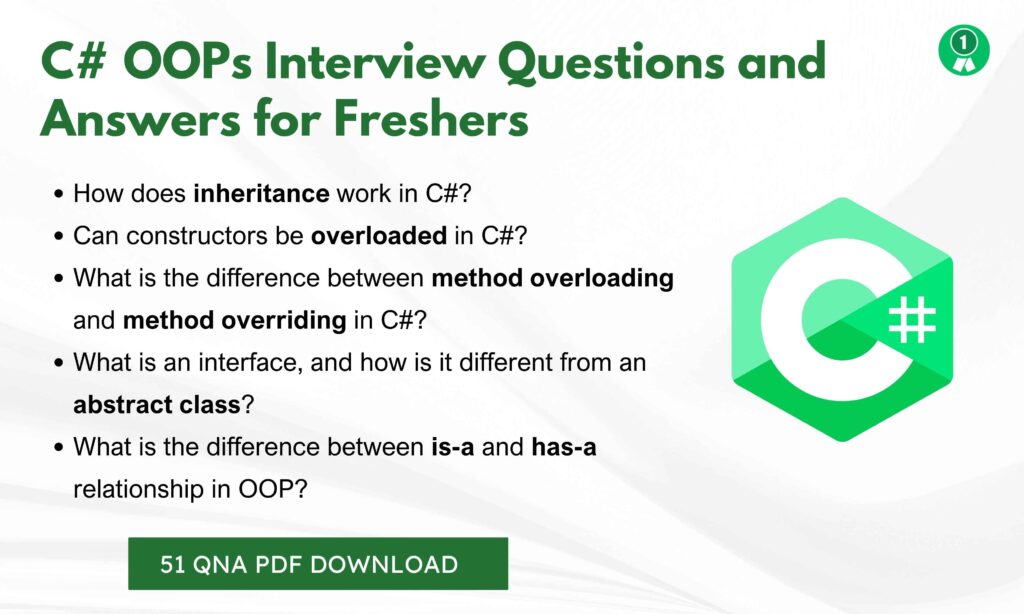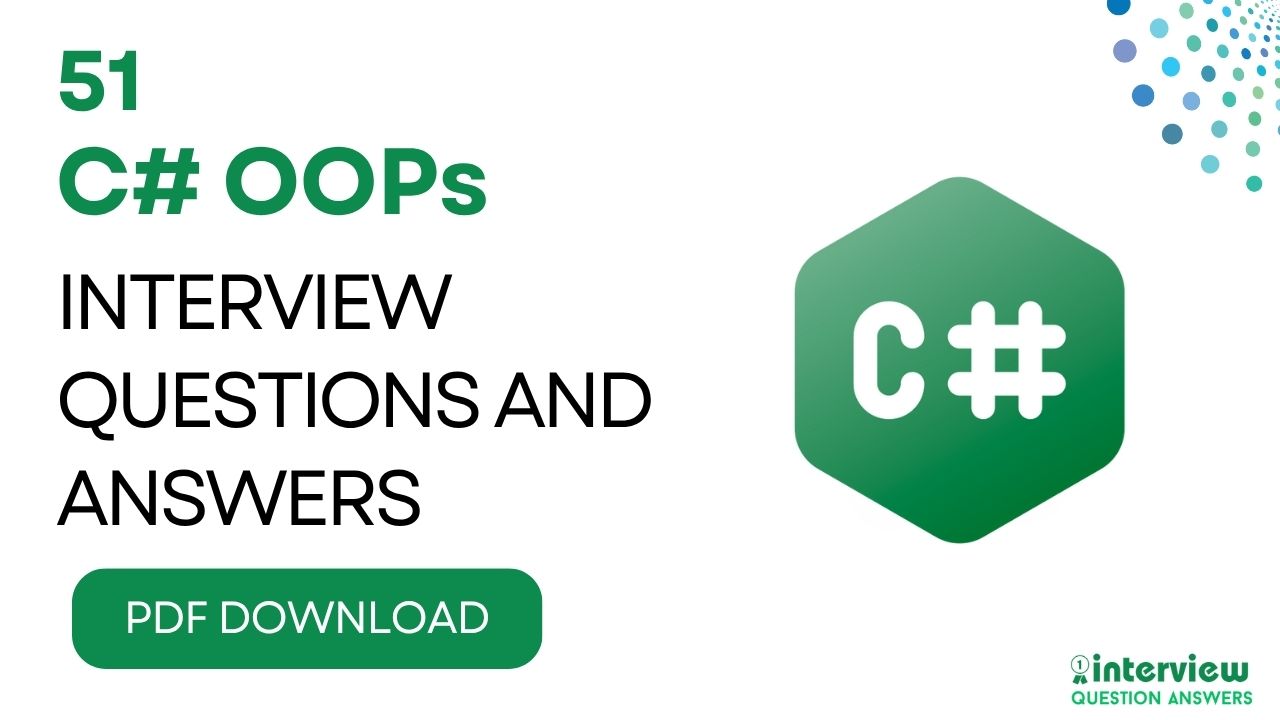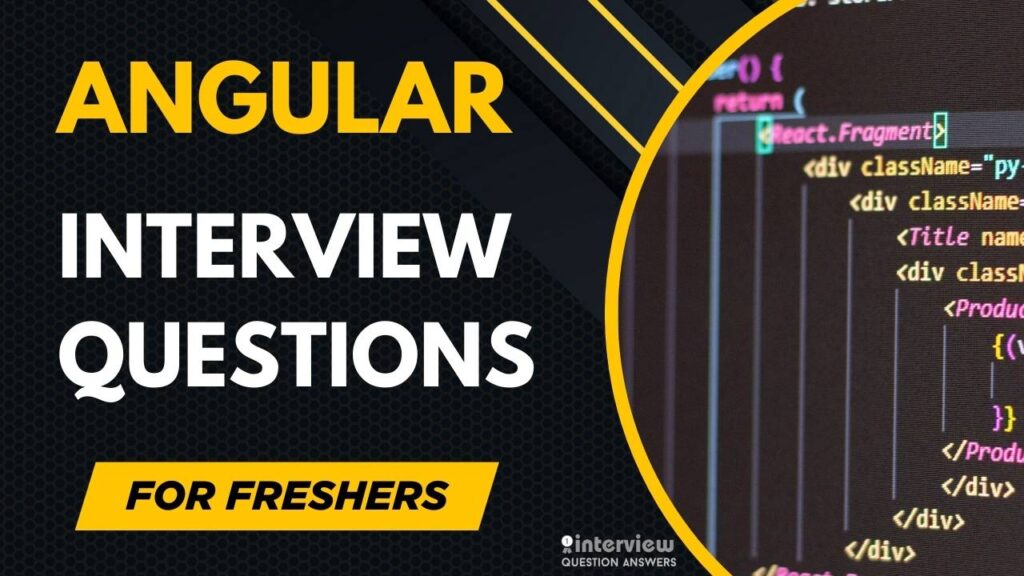If you want to work as a C# developer, you absolutely need to understand Object-Oriented Programming (OOP). It doesn’t matter if you’re going for your first job or you’ve been coding for years, OOP is everywhere in C#. The main ideas like inheritance (sharing code between classes), encapsulation (protecting your data), abstraction (hiding complicated stuff), and polymorphism (same method working differently) are built right into how C# works.
When you go for interviews, both HR people and technical folks will ask you about OOP. They’re trying to figure out if you really know your stuff, how you solve problems, and whether you can design good code. It’s not just about memorizing definitions, they want to see you can actually use these concepts.
We’ve put together OOPs interview questions here for everyone. If you’re just starting out, there are basic questions to get you going. For people who’ve been around the block, we have tougher questions about system design and architecture. We have also added some scenario-based questions that test how you’d handle real situations at work.
Table of Contents
C# OOPs Interview Questions and Answers for Freshers
Que 1. What is the purpose of using classes and objects in C#?
Classes define the blueprint of an object, and objects are instances of classes. Using classes and objects helps organize code around real-world entities, making it more modular, reusable, and easier to maintain in C# applications.
Que 2. What is the difference between a class and a struct in C#?
A class is a reference type, stored on the heap, and supports features like inheritance and polymorphism. A struct is a value type, stored on the stack, and does not support inheritance. Structs are used for lightweight objects.
Que 3. How does inheritance work in C#?
Inheritance in C# allows a class (child/derived) to inherit members (fields, methods, properties) from another class (parent/base). It promotes code reuse and logical hierarchy.
Que 4. What is encapsulation in C#?
Encapsulation is the practice of wrapping data and methods into a single unit (class) and restricting direct access using access modifiers like private, protected, and public.
Que 5. What is abstraction in C#?
Abstraction hides complex implementation details and shows only essential features. In C#, it is implemented using abstract classes or interfaces.
Que 6. What is polymorphism in C#?
Polymorphism allows objects to be treated as instances of their parent class, enabling method overriding and method overloading. It enhances flexibility and scalability in code.
Que 7. What is the difference between method overloading and method overriding in C#?
Method overloading allows multiple methods with the same name but different parameters in the same class. Method overriding allows a derived class to provide a new implementation of a method defined in the base class.
Que 8. Can constructors be overloaded in C#?
Yes, constructors in C# can be overloaded by defining multiple constructors with different sets of parameters in the same class.
Que 9. What is a virtual method in C#?
A virtual method in C# is a method in a base class that can be overridden in a derived class using the override keyword. It supports runtime polymorphism.
Que 10. What is an interface and how is it different from an abstract class?
An interface defines a contract with only method signatures, while an abstract class can have method implementations. A class can implement multiple interfaces but only inherit one abstract class.
Que 11. How does the sealed keyword work in C#?
The sealed keyword prevents a class from being inherited. When applied to a method, it stops further overriding in derived classes.
Que 12. Explain the role of the base keyword in C#.
The base keyword is used to access members of the base class from within a derived class. It’s commonly used to call base class constructors or methods.
Que 13. What is a static class in C#?
A static class cannot be instantiated and can contain only static members. It is often used to group utility or helper methods.
Que 14. Can C# support multiple inheritance?
C# does not support multiple inheritance with classes but allows multiple interfaces to be implemented, enabling a form of multiple inheritance.
Que 15. What is the difference between is-a and has-a relationship in OOP?
An is-a relationship is established through inheritance (Dog is-an Animal), while has-a refers to composition or aggregation (Car has-an Engine).
Que 16. How is encapsulation achieved in C#?
Encapsulation is achieved using access modifiers like private, public, protected, and properties that control access to fields using get and set.
Que 17. What is the purpose of the new keyword in method hiding?
When a method in a derived class has the same name as in the base class, using the new keyword hides the base method, allowing the derived version to execute.
Que 18. What is a constructor initializer in C#?
A constructor initializer (: this() or : base()) allows one constructor to call another within the same class or in the base class, promoting code reuse.
Que 19. How does access modifier protected differ from private?
private members are accessible only within the same class, while protected members are accessible within the same class and its derived classes.
Que 20. Provide an example of polymorphism using a base class and derived class in C#
public class Animal {
public virtual void Speak() {
Console.WriteLine("Animal speaks");
}
}
public class Dog : Animal {
public override void Speak() {
Console.WriteLine("Dog barks");
}
}
// Usage
Animal myDog = new Dog();
myDog.Speak(); // Output: Dog barksThis demonstrates runtime polymorphism using method overriding.

Also Check: C# Interview Questions and Answers PDF
C# OOPs Interview Questions and Answers for Experienced
Que 21. How do you implement custom exception handling using OOP principles in C#?
Custom exception handling leverages inheritance by extending the base Exception class. You can create meaningful error types and maintain encapsulation.
public class InvalidUserInputException : Exception {
public InvalidUserInputException(string message) : base(message) {}
}Que 22. How does relate the IDisposable interface to OOP principles?
IDisposable defines a contract that promotes abstraction and encapsulation. When implemented, it allows a class to manage resource cleanup via the Dispose method, often used with the using statement.
Que 23. What is the difference between composition and inheritance? When to prefer one over the other?
Composition models “has-a” relationships and promotes code reuse by containing instances of other classes. Inheritance models “is-a” relationships and establishes a hierarchy. Prefer composition for flexibility and loose coupling.
Que 24. Explain how dependency injection supports OOP design principles.
Dependency Injection supports abstraction and loose coupling, allowing dependencies to be passed in at runtime rather than hard-coded, which follows the Open/Closed Principle from SOLID.
Que 25. How is method hiding different from overriding in C#?
Method hiding uses the new keyword and is resolved at compile time. Method overriding uses the override keyword and is resolved at runtime using polymorphism.
| Feature | Method Hiding (new) | Method Overriding (override) |
|---|---|---|
| Resolution | Compile-time | Runtime |
| Base Method Call | Executes base version | Executes overridden version |
| Keyword Used | new | override |
Que 26. What is object slicing and does it apply in C#?
Object slicing is when a subclass object is assigned to a base class object and subclass-specific data is sliced off. This issue occurs in C++ but is avoided in C# due to references and polymorphism.
Que 27. Can we override static methods in C#?
No, static methods belong to the class, not the instance. Since polymorphism works with instances, static methods cannot be overridden but can be hidden using the new keyword.
Que 28. Explain the concept of late binding with an example in C#.
Late binding refers to resolving method calls at runtime. In C#, it’s achieved via virtual methods or using dynamic.
dynamic obj = new SomeClass();
obj.SomeMethod(); // Resolved at runtimeQue 29. What is covariance and contravariance in C# OOP?
Covariance allows a method to return a more derived type than declared. Contravariance allows passing a less derived type. They apply to delegates, generics, and interfaces.
IEnumerable<string> strings = new List<string>(); // Covariance
Action<object> act = (obj) => Console.WriteLine(obj);
Action<string> act2 = act; // ContravarianceQue 30. What design patterns are used in large-scale OOP-based C# applications?
Common ones include Singleton, Factory, Strategy, Observer, and Dependency Injection. These promote reusability, separation of concerns, and flexibility in architecture.
Que 31. How would you implement a Factory Pattern in C#?
Factory Pattern creates objects without specifying the exact class. It uses a method to return different implementations based on input.
public interface IAnimal { void Speak(); }
public class Dog : IAnimal { public void Speak() => Console.WriteLine("Dog"); }
public class Cat : IAnimal { public void Speak() => Console.WriteLine("Cat"); }
public static class AnimalFactory {
public static IAnimal GetAnimal(string type) {
return type == "dog" ? new Dog() : new Cat();
}
}Que 32. How can OOP principles help in unit testing C# code?
Encapsulation and abstraction make components testable in isolation. Dependency Injection helps in mocking dependencies, and inheritance allows for testing base class logic.
Que 33. What is the purpose of the abstract keyword in C#?
The abstract keyword allows you to define methods and classes that must be implemented in derived classes. It ensures that specific functionality is enforced in a contract form.
Que 34. Explain the use of interface segregation principle in real-world C# apps.
It suggests that no client should be forced to depend on interfaces it does not use. In practice, instead of having one bloated interface, you create smaller, more specific ones.
public interface IPrinter { void Print(); }
public interface IScanner { void Scan(); }Que 35. Can a class implement multiple interfaces in C#? How does that align with OOP?
Yes, C# supports multiple interface implementation, promoting abstraction and loose coupling. It aligns with OOP by allowing a class to fulfill multiple contracts.
Que 36. What is shadowing in C# and how is it different from overriding?
Shadowing occurs when a derived class defines a member with the same name as in the base class using new. It does not participate in polymorphism.
Que 37. Explain object pooling and its relation to OOP concepts.
Object pooling is a memory management pattern that reuses objects instead of creating/destroying them repeatedly. It supports OOP principles like performance optimization and encapsulation.
Que 38. What’s the impact of using reflection in OOP-heavy C# systems?
Reflection allows inspection of types and members at runtime. It breaks encapsulation to some extent but is powerful for dynamic object manipulation or building frameworks.
Que 39. What are extension methods and how do they relate to OOP?
Extension methods allow adding methods to existing types without modifying them, supporting the Open/Closed Principle. They work like static methods but appear as instance methods.
public static class StringExtensions {
public static int WordCount(this string str) => str.Split(' ').Length;
}Que 40. How do access modifiers support the OOP principle of encapsulation in C#?
Access modifiers like private, protected, and internal control member visibility, enforcing encapsulation by hiding implementation details and exposing only necessary parts.
Also Check: Python OOPs Interview Questions
C# Scenario Based OOPs Interview Questions
Que 41. You have a legacy class with critical business logic, but it’s tightly coupled. How would you refactor it using OOP principles?
Apply abstraction and dependency injection to isolate the logic. Extract interfaces, introduce loose coupling, and ensure the class adheres to SOLID principles, particularly the Single Responsibility and Open/Closed principles.
Que 42. In your C# project, you need to share a method across multiple unrelated classes. What OOP approach would you take?
Use interface implementation for shared behavior or create an abstract base class if partial implementations are needed. If static utility is acceptable, use static helper classes.
Que 43. You’re asked to implement a plugin-based system. How would you design it using OOP?
Design with interfaces (e.g., IPlugin) and load implementations dynamically using reflection. This follows the Dependency Inversion Principle and enables loose coupling and extensibility.
public interface IPlugin {
void Execute();
}Que 44. You notice duplicate code in multiple classes. How do you handle it without violating OOP principles?
Use inheritance if the classes are related or apply composition to extract shared functionality into a reusable class. Avoid code duplication by following DRY (Don’t Repeat Yourself) and the Open/Closed Principle.
Que 45. You’re building an API and need to hide complex logic from the consumer. What OOP approach would you use?
Encapsulation is key. Wrap complex logic inside private methods and expose only necessary operations via public methods. You may also use facade patterns for abstraction.
Que 46. A team member uses public fields in a class. What would you recommend and why?
Suggest replacing public fields with private fields and public properties to maintain encapsulation and enable validation, logging, or control during data assignment.
private int _age;
public int Age {
get => _age;
set {
if (value < 0) throw new ArgumentException();
_age = value;
}
}Que 47. You need to model a car manufacturing process where different types of cars share behavior but differ in features. How would you model it?
Use an abstract base class like Car with common members, and derive specific types (Sedan, SUV, etc.). For flexible feature changes, use the Strategy pattern or composition.
Que 48. You want to ensure only one instance of a class exists in the application. What OOP pattern will you use?
Use the Singleton pattern. Ensure thread safety using Lazy<T> or lock mechanisms.
public sealed class Singleton {
private static readonly Lazy<Singleton> _instance = new(() => new Singleton());
public static Singleton Instance => _instance.Value;
private Singleton() {}
}Que 49. A class has grown too large and is handling multiple unrelated responsibilities. How would you refactor?
Apply the Single Responsibility Principle. Split the class into smaller, focused classes that each handle a specific concern, and coordinate them using composition.
Que 50. You’re asked to ensure that your C# application supports testing and mocking. How would you design your classes?
Design classes with interfaces, use constructor injection for dependencies, and avoid static dependencies. This improves testability and promotes loose coupling.
Que 51. You’re joining a project where multiple inheritance is simulated using interfaces. Why might the original developers do this?
C# doesn’t support multiple class inheritance. Developers use multiple interface implementation to achieve polymorphism and separation of concerns while avoiding the diamond problem of multiple inheritance.
Also Check: Java OOPs Interview Questions
C# OOPs Interview Questions PDF
To help with offline preparation, we’re also offering a PDF version of all the C# OOPs interview questions and answers.
This includes structured content for freshers, experienced professionals, and scenario-based questions. It’s perfect for quick revisions before interviews or sharing with your peers.







